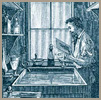John Thomson and photography
The majority of John Thomson's photographic work was produced using what is known as the 'wet-collodion' process. Wet-collodion was the most commonly used process to create a photographic negative (on glass) in the second half of the 19th century. This technology was complex in its operation, the equipment cumbersome to handle, the process time-consuming, and it depended on a large number of variables for consistency and quality; but it was nevertheless a process which enabled images of great beauty and high definition to be created, especially in the hands of a master practitioner like John Thomson.
Thomson used a variety of cameras, both full-plate and stereo, although none of his instruments have survived. They had to be strong and relatively portable, and were made from hard woods to withstand tropical climates.
Thomson also wrote extensively on photography. He contributed numerous articles to photographic journals, such as the 'British Journal of Photography', and edited and translated Gaston Tissandier's 'History and Handbook of Photography' (1876) which became a standard reference work.
 Home
Home

